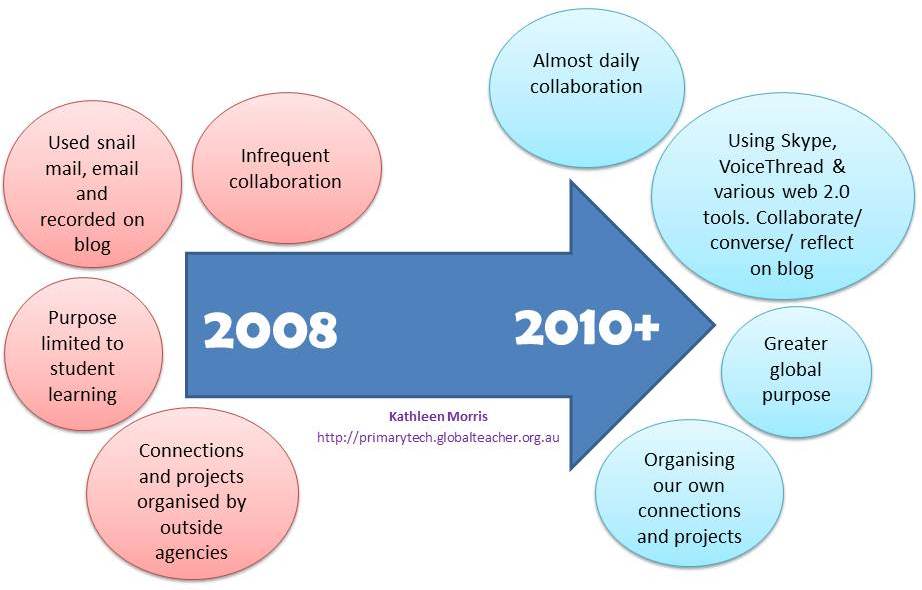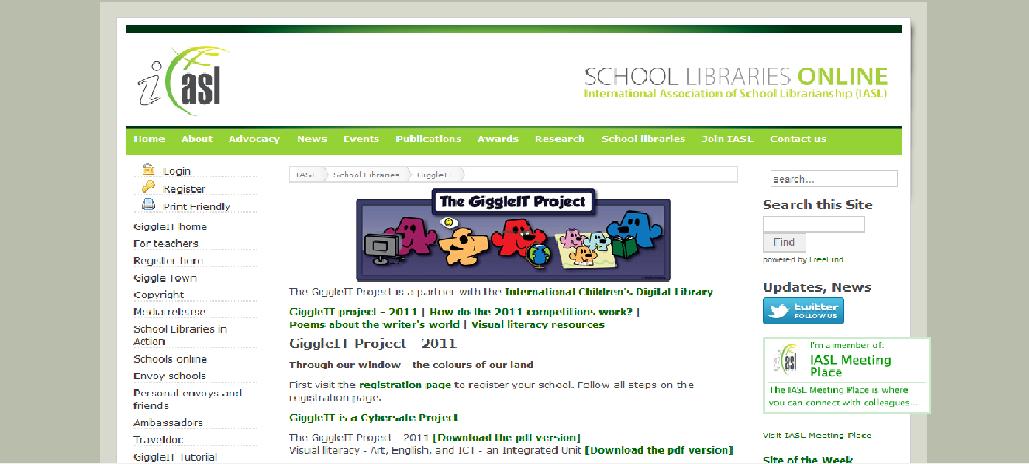Kathleen Morris is a grade two teacher from Leopold Primary School, Victoria. Kathleen has an inspirational blog called Integrating Technology in the Primary Classroom, where she shares her experiences, resources, and advice concerning blogging, global collaboration, and technology integration.
Kathleen has agreed to share her wonderful experiences with collaborating globally, in a joint post between Bright Ideas and Integrating Technology in the Primary Classroom. We hope together we can inspire more teachers to make connections and open up whole new worlds for their students.
Below, Kathleen outlines her experiences from the first global collaboration in 2008 to now, showing that her classroom experiences of collaboration have become more integrated, frequent, and richer.
I created the following diagram to demonstrate how my involvement in global collaboration has progressed (tip: click on image if you want to see it more clearly).

A summary of how I progressed with global collaboration
2008
Christmas Card Exchange Project organised through iEARN: our class was matched with seven schools around the world and we exchanged Christmas/holiday cards.
PROS – Learning about all the different countries involved and their holiday traditions.
CONS – Lack of “real” connection to the classes and lack of technology used (the contact was slow!).
2009
Teddy Bear Exchange Project organised through iEARN: our class was matched with a class in Canada. We exchanged teddies via snail mail and we “helped” the teddies write weekly emails to each other. We collated all the emails on a page on our class blog.
PROS – We learnt a lot about life in Canada; children learnt about email.
CONS – There wasn’t the chance for a “real” connection to develop between students – it was all through the teddy.
*****
Blogging Buddies: in our second year of blogging we began forming connections with many classes around the world. We would leave comments on our new friends’ blogs and keep track of what they were up to in an informal manner.
PROS – Blogging suddenly become more powerful, interesting and meaningful as we had a real international audience. Students began to learn there was a life outside of their neighbourhood.
CONS – All our interactions and learning was “ad-hoc”.
2010 – first half
Our relationships with our blogging buddies continued and expanded while we looked to more structured, self-organised and personalised projects.
Collaboration Corner http://collaboration-corner.blogspot.com
I created a blog with Linda Yollis in California. Our classes had got to know each other since early 2009 via our class blogs.
We called the blog “Collaboration Corner”. This was a place for the students to work on projects together and have rich discussions through commenting.
We had two main projects in the first half of the year:
• Lunch Box Project – this complimented our “Food” theme. A child from each class took turns making a post about their lunch. They used a tool like Fotobabble to narrate a picture of their lunch. Some great conversations got going in the comments on healthy eating, food preferences, cultural difference with food, food groups etc.
• Our School – the students used tools like VoiceThread and video to show their American friends around their school. The students made posts about the play areas, library, office etc. The students were really interested to compare how school is the same and different in Australia and the US.
PROS – The students got to really connect with their blogging buddies and the blog provided a window into their lives. Skype was used to enhance this connection such as our Skype breakfast party. A lot of content was learnt about food, time zones, schools, geography. A lot of reflection and new ideas also arose.
CONS – We were working together and learning a lot but what for?
2010 – second half
Ugandan Global Project http://ugandanglobalproject.blogspot.com
This is an idea I came up with because I loved how my students were learning and connecting with their buddies overseas but I thought something was missing. I knew we could take it further. I wanted my students to be able to use these global connections for a greater good; to raise their social conscience, help others and learn more about the world in which they live.
In this project, we set up another blog and invited some of our blogging buddies to join in. We had two Australian classes, three American classes and one Chinese class involved all working together to help out a school in Uganda.
The students were sponsored by their family and friends and at 10am on Friday 22nd October, all the classes around the world ran/walked for one hour to earn their sponsorship money.
Throughout the project all the classes involved worked on various tasks to learn more about Uganda and put up posts on the blog on topics such as
• A day in the life of a student in Australia/USA/China/Uganda
• A traditional song in each country
• The run/walk event in each location
• Time zones
• Currencies
Behind these posts, the commenting was fantastic! The students (all aged 7-9) were involved in some rich conversations.
This project raised $20,000 which is making an enormous difference in the lives of our Ugandan friends.
There are also incredible flow-on effects still happening. A group of Americans who followed our project blog decided to volunteer at the Ugandan school. There are around 20 of them in Uganda at the time of writing and they’re making an invaluable contribution. Additionally, a teacher who read about our project contacted the school founder asking how she can help. The possibilities of these after effects are endless.
I feel that one of the ultimate goals of being a global citizen is to be able to work together for a common good, be understanding of others and have a social conscience. Through blogging, my students are developing as effective global citizens and I’m so proud of what they are achieving! I can’t wait to see where we’ll go next…
What next?
Needless to say, I want my students to be involved in more global collaboration in the future. I think a mix of informal collaboration and more structured projects works well. We’re now at a point where we don’t need to look at projects organised by outside agencies as we are part of a large international blogging community.
When it comes to projects, I like the idea of working on some projects that are simply designed to increase student learning and global awareness, while also aiming for perhaps an annual big project (like the Ugandan Project) where the aims go beyond individual student learning.
How to get started
If you want your class to connect and collaborate globally, I recommend you read this post by Edna Sackson “10 Ways to Create Global Connections”
If you want to start in a more structured way like I did, there are many free and paid organisations co-ordinating global collaborative projects.
You might like to try…
http://www.globalschoolnet.org/
http://www.iearn.org.au/
http://www.theteacherscorner.net/penpals/
http://www.epals.com
http://www.ozprojects.edu.au



